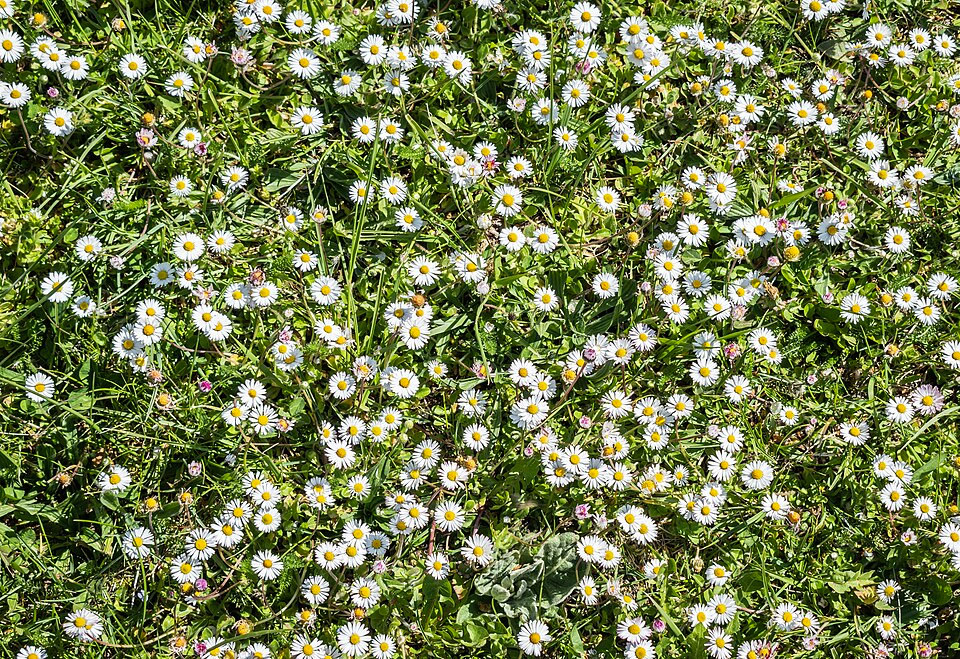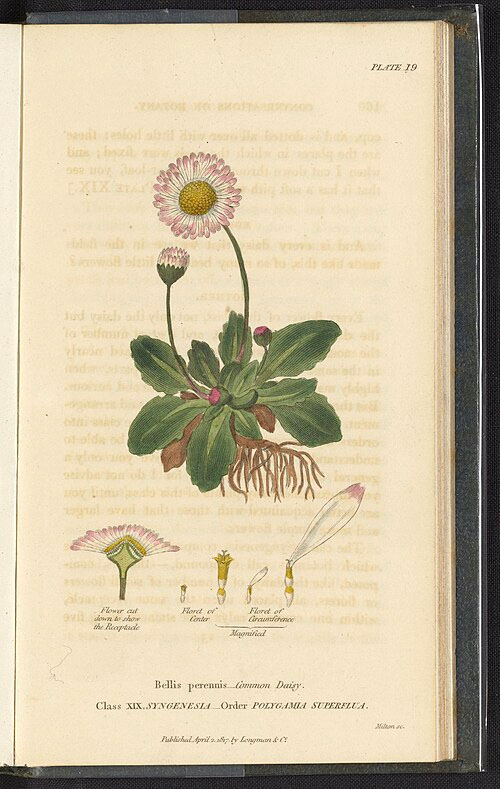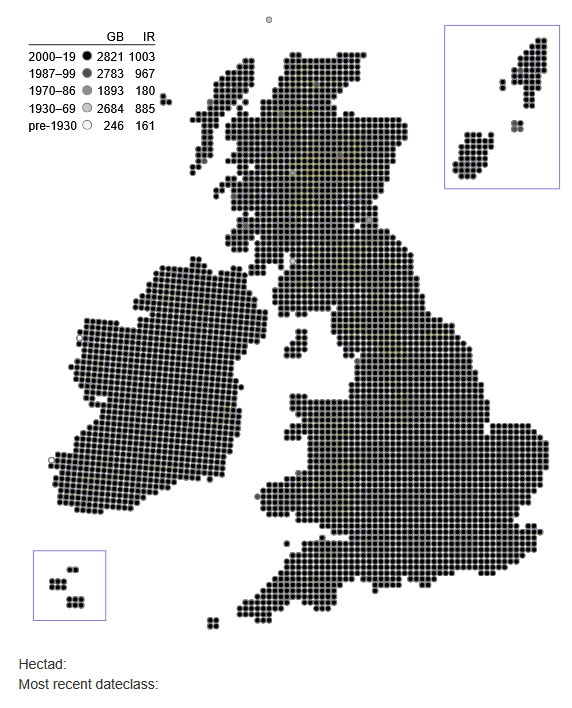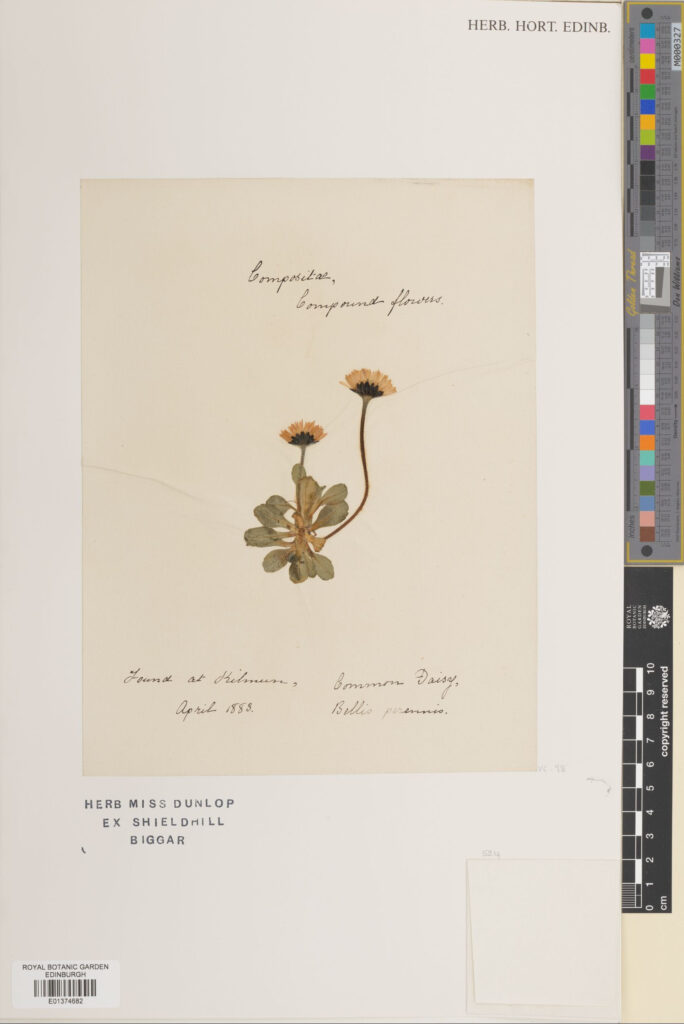The following blog was written by Courtney Kemnitz a digitiser in the Herbarium.
Since 2021 we have increased our digitisation capacity with the goal of getting to 1 million specimens imaged by Autumn 2024. Courtney is working through our British and Irish collections. This series of blogs will spotlight the species that have been completed.The following blog was written by Courtney Kemnitz a digitiser in the Herbarium.
Bellis perennis, the common daisy, is a familiar wildflower native to the UK and Ireland. Its name originates from the Anglo-Saxon “daegeseage” (day’s eye), reflecting its habit of opening with the sun and closing at night. This sun-linked behavior contributes to its symbolism of innocence, purity, and new beginnings. While “daisy” is a common name for various flowers worldwide (e.g., Gerbera daisy/Gerbera jamesonii, Ox-eye daisy/Leucanthemum vulgare), Bellis perennis is considered the original “true” daisy.

The Many Forms of a Daisy Chain
Bellis perennis is intrinsically linked with the creation of chains, especially during spring and summer. Aside from being a fun activity, particularly among children, the term ‘daisy chain’ has lent itself to many other areas and has many different meanings depending on the context, for example:
Crochet: also known as a ‘daisy stitch’. It is a type of stitch where a series of loops or stitches are created that resemble the petals of a daisy
Computing & Electrical Systems: refers to the connecting of multiple units in a series or loop.
Climbing: a type of strap with multiple loops, used for connecting oneself to anchors
Fishing: type of fishing lure that has many lures connected in a series
Commerce: a series of transactions designed to manipulate prices, often in the stock market
Transplant surgery: Typically used in kidney transplants (a “paired donation”), it’s a system of donation chains that link incompatible donor-recipient pairs, enabling recipients to receive compatible kidneys from other donors within the chain, maximizing transplants.

How to make a Daisy Chain
Daisy chains are made by weaving stems together.
- Prepare the first daisy: using your fingernail, make a slit in the first flowers stem about 2.5-3cm (about 1 inch)
- Thread the second daisy by carefully through the slit of the first stem and gently pull it until the flower head rests snugly against the first stem
- Repeat by making similar slit in the second stem and thread the third daisy and so on until you reach the desired length
- Finish the chain by making a second slit in the first daisy’s stem (about 2.5-3cm down from the first slit) and thread the last flower through it.
A closer look
Name: Bellis perennis L.
Family: Asteraceae (Compositae)
It was first described scientifically in 1753 by Swedish botanist Carl Linnaeus in Species Plantarum
Common Names* in the British Isles and the Isle of Ireland
- English: daisy, common daisy, lawn daisy, English daisy
- Scots: gowan [GOW-an]
- Scottish Gaelic: gùgan [gu-gan], dìthean [jee-han]
- Irish: nóinín [n-oh-NIN]
- Welsh: llygad y dydd [luh-gahd uh Dee-ee]
- Manx: neaynin bane [NAY-nin BAWN]
- Cornish: kaja [kay-ya]
*list not exhaustive

Bellis perennis is a perennial plant that grows close to the ground, typically in sunny environments. It can be found in a variety of habitats, including grasslands and woodlands. This plant can reach 10cm in both height and spread. It blooms from early spring to late autumn (March to October).
Flowers
The flower head of Bellis perennis is not a singular flower, but a composite of many tiny flowers. It is made up of two types of florets (small flowers). The central yellow section is made up of ‘disc florets’ (tubular flowers). The center is then surrounded by tiny white (or sometimes pink) ‘ray florets’ (strap-shaped flowers) that resemble petals. This arrangement gives Bellis perennis the appearance of having a singular flower. It has an overall average diameter of 1-2cm.

Leaves
The leaves are dark green and spoon-shaped. They are 2-5cm long and form a central rosette at the base of the stem.

Royal Botanic Garden Edinburgh (RBGE) Herbarium Specimens
The digitisation of this species within our British Isle collections is now complete which allows us to see how our collections are distributed and compare this to the species range data recorded by the Botanical Society of the British Isles.
Total number of Specimens held in the British and Irish Collection within the Herbarium*: 66 Specimens
Our
*Please note, that the Herbarium contains more specimens of Bellis perennis from other parts of the world. These figures are not included.
Breakdown by Region
| Country | Specimen Count |
| Scotland | 51 |
| England | 14 |
| Wales | 0 |
| Channel Islands | 1 |
| Ireland (Republic of Ireland & Northern Ireland) | 0 |
Distribution
Bellis perennis is widely spread throughout Britian and Ireland. It’s native range also includes: Europe, Western Asia, and North Africa. It has since naturalized across most temperate climates globally, establishing itself in places like North America, Central Asia, and the South Pacific.

For a map of the worldwide distribution of Bellis perennis L. please visit the website: Plants of the World Online.


Uses, Past & Present in the British Isles and the Isle of Ireland
- Medicine
- Ornamental
- Magic/Divination
- Food
Sayings from the British Isles and the Isle of Ireland
Here are a few sayings referencing the daisy:
“to push up daisies” or “to turn one’s toes up to the daisies” – a euphemism for being dead and buried, and thus helping to the fertilise the daisies that grow above burials.
“Fresh as a daisy” – someone is looking well rested and full of energy
“whoops-a-daisy” or “Oops-a-daisy” – light-hearted exclamation after a minor mishap or clumsy action. Said to downplay the incident and add a bit of humour.
“Ups-a-daisy” – used as encouragement for someone who has fallen or struggling to get up and is often used with children.
“when you can put your foot on seven English daisies, summer is come” reflects the daisy’s abundance in spring and early summer, signalling the arrival of warmer weather
Literary References
The inclusion of Bellis perennis or daisy, in literature signifies its cultural importance and the profound interplay between nature and storytelling in the UK and Ireland. Here are a few instances of literary references to daises in the UK and Ireland:
| “That is a trewe tale, by myn hood,” / Quod Love, “and that thou knowest wel, pardee, / If hit be so that thou avyse thee. / Hastow nat in a book, lyth in thy cheste, / The grete goodnesse of the quene Alceste, / That turned was into a dayesye: / She that for hir husbande chees to dye, / And eek to goon to helle, rather than he, / And Ercules rescowed hir, pardee, / And broghte hir out of helle agayn to blis?” | [Translated from Middle English] “‘That is true indeed, by my own selfhood,’/ Quoth Love, ‘you have knowledge, I see, / If that is what you think, but now tell me, / Have you not read in a book, in your chest,/ Of the great goodness of Queen Alceste, / Who became the daisy, the day’s eye; / She that for her husband chose to die, / And thus to go to Hell rather than he, / She who was rescued then by Hercules, / Who brought her out of Hell again to bliss?’ ” |
Excerpt From “The Legende of Goode Women” by Geoffrey Chaucer (c.15th century). Translated by A. S. Kline, 2008
“Wee, modest, crimson-tippèd flow’r,
Thou’s met me in an evil hour;
For I maun crush amang the stoure
Thy slender stem:
To spare thee now is past my pow’r,
Thou bonie gem. ”
Excerpt From ‘To a Mountain Daisy’ by Robert Burns (1786)

“Daisies burn April grass with silver fires”
Excerpt From ‘The Day’s of April’ by John Clare (1830)
“So she was considering in her own mind (as well as she could, for the hot day made her feel very sleepy and stupid), whether the pleasure of making a daisy-chain would be worth the trouble of getting up and picking the daisies, when suddenly a White Rabbit with pink eyes ran close by her.”
Excerpt From ‘Chapter 1: Down the Rabbit-Hole’ in ‘Alice’s Adventure in Wonderland’ by Lewis Carroll (1865)
“Now, become as the leaf or the daisy, lying recumbent, staring straight up, the sky is discovered to be something so different from this that really it is a little shocking.”
Excerpt from ‘On Being Ill’ by Virginia Woolf (1925)
“In the scented bud of the morning – O,
When the windy grass went rippling far,
I saw my dear one walking slow
In the field where the daisies are.”
Excerpt from ‘The Daisies’ By James Stephens (1926)
“…‘This’ll puzzle the nasty little underground creature’ he thought:
An eye in a blue face
Saw an eye in a green face
‘That eye is like to this eye’
Said the first eye,
‘But in low place
Not in high place’
‘…Ss,ss, ss, my precious’ he said. ‘Sun on the daisies it means, it does.’ “
Excerpt from Chapter 5 Riddles in the Dark, The Hobbit by JRR Tolkien (1937)
Bellis perennis, is far more than a common lawn flower in the UK. Whether it’s the subject of a romantic verse, a childhood memory of making daisy chains, or a playful verse, it’s a reminder of the enduring connection between humans and the natural world.
